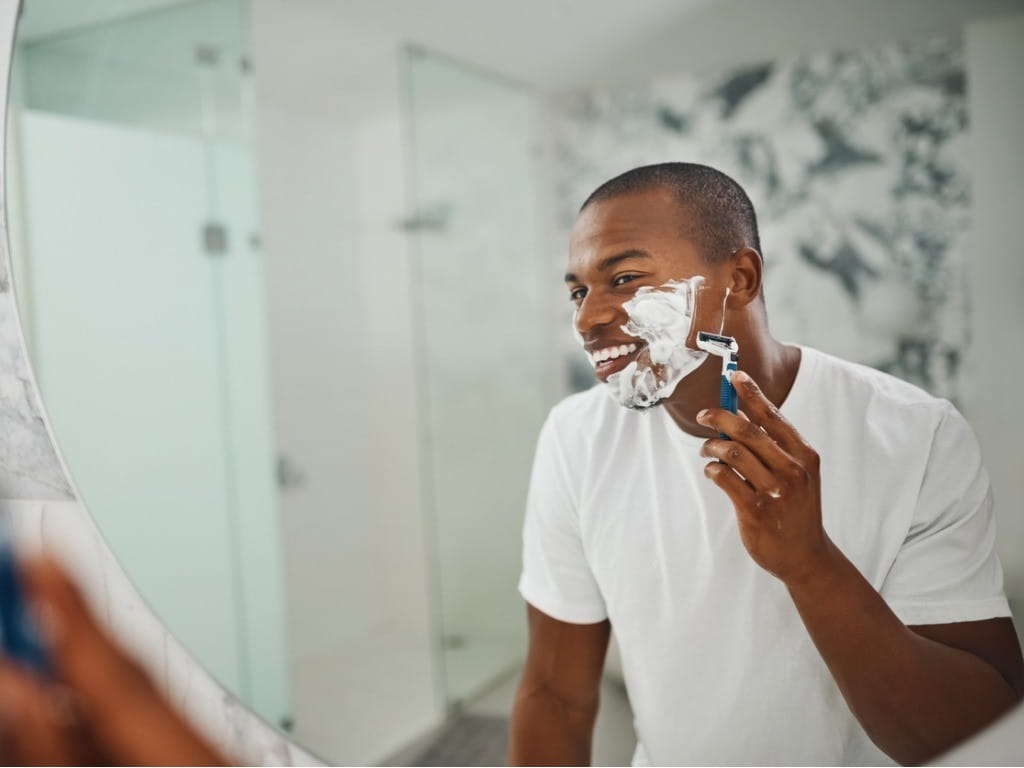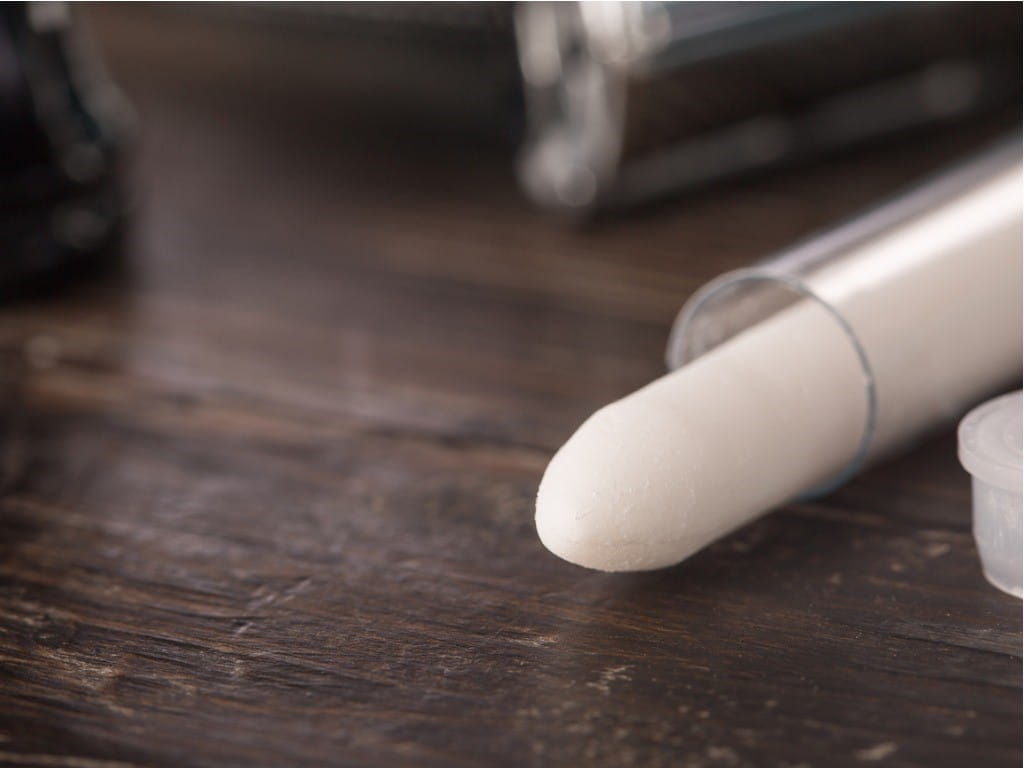Are Styptic Pencils Poisonous?

The Bottom Line
Styptic pencils contain aluminum compounds and are used to stop bleeding. The most common use for styptic pencils is to treat small cuts caused by shaving. When applied to the skin, they harden or coagulate the surface of a wound. However, they are not meant to be consumed and may cause stomach upset or nausea if swallowed.

The Full Story
The word "styptic" is not one that you hear too often today. Styptics are products that are used to stop bleeding. The root words refer to items that cause contracting or closing up of the tissue. We more often hear the word "astringent" used in the same way, but astringents are used to contract pores on the face, for example. The most common use for styptic pencils is to treat small cuts caused by shaving.
Styptic pencils stop bleeding by hardening or coagulating the surface of a wound, just like a scab.
A styptic pencil is often formulated with aluminum salts like aluminum sulfate, potassium aluminum sulfate, or sodium aluminum sulfate. Sometimes these compounds are collectively called alum. Through history the words "styptic," "astringent," and "alum" have all been used to describe something that tasted bitter and would make your mouth pucker. Styptic pencils work by separating proteins in the blood, causing it to clot more effectively. The aluminum powder compounds are formed into a short pencil shape to be kept nearby when someone is shaving. When a cut happens, you run the pencil under water and then hold it to the cut for a few seconds. The bleeding should stop quickly, and the process can be repeated again if needed. The user is likely to feel a stinging sensation but there is minimal absorption of aluminum into the human body.
Styptics can also be used in powder and liquid formulations. For example, alum is used to wash the bladder during certain medical conditions where there is inflammation and bleeding present. Cases of serious toxicity (including sedation, confusion, and seizure) have been reported after use of alum in these procedures, which are performed continuously over 24 hours or more, but not from topical use of styptic pencils.
Aluminum is the third most common element found in the Earth's crust. Humans are exposed to aluminum and other heavy metals daily, mostly through the air we breathe as well as the food we eat. When swallowed, high doses of aluminum can be irritating to the stomach—almost all metals and minerals can be. If an adult or child takes a bite from a styptic pencil, they might vomit or have some nausea. These symptoms are likely to resolve quickly. A snack and something to drink can help to buffer these effects. Styptic pencils can also break into smaller pieces and fall to the floor, making them more accessible to children. When any foreign body is swallowed, it comes with the risk of choking or blocking the airway. The astringent taste should be off-putting, but that does not always keep children from swallowing a substance. As with any foreign body ingestion, call 911 immediately if the child appears to have any trouble breathing.
Aluminum’s irritant properties are also responsible for the redness, itching, or mild pain that may occur after use of a styptic pencil. This irritation is generally mild and should resolve after a short period of time. Aluminum sulfate is sometimes added to the public drinking water supply as part of the purification and filtration process. The addition of too much aluminum to the water supply can alter the pH of the water, causing increased release of heavy metals including copper, lead, and nickel into the water supply. The presence of these metals in the water supply may cause skin irritation and rashes in some people.
The human eye is also susceptible to the irritant effects of aluminum. Eye injury, including visual changes and corneal damage, has been reported to occur after application of aluminum to the eye. Since eye exposure to styptics potentially cause long-term eye damage, immediate eye irrigation should be performed if aluminum gets into the eye. Contact lenses should be removed immediately, and irrigation with room-temperature tap water should be performed for 15-20 minutes. Eye irrigation can be performed by letting water from the kitchen sink or bathroom shower run over the eye, or through use of a pitcher to pour water over the eye.
Aluminum is excreted by the kidneys. Those with impaired kidney function might accumulate aluminum and be more likely to have rare adverse reactions, but even in this population an accidental taste of a styptic pencil should be okay.
If someone has swallowed part of a styptic pencil, get help with the webPOISONCONTROL® online tool or call 1-800-222-1222. Whether you log on or call, Poison Control expert assistance is available 24 hours a day.
Pela Soto, PharmD, BSHS Pharmacogenomics, BS Microbiology
Certified Specialist in Poison Information
Poisoned?
Call 1-800-222-1222 or
Prevention Tips
- Styptic pencils should be kept away from children and pets.
- Styptic pencils are powders formed into a pencil shape, and they can crumble. Clean up crumbles that fall to the floor to prevent little ones from putting them into their mouths.
- Wash your hands after using styptic pencils to avoid cross-contamination of eyes and skin.
This Really Happened
A 23-year-old man wanted to make geodes using instructions that he found online. Alum was one of the powdered ingredients that he used. He was not wearing a mask and 30 minutes after using the products he became dizzy and nauseated. He was worried about toxicity and called Poison Control, which recommended that he wash he gently wash his nostrils and exposed skin. It is possible that some of the dust was inhaled and swallowed, causing some nausea, but he was not going to be in any substantial danger for toxicity. He was back to normal about an hour later. Poison Control recommended that he use personal protective equipment next time.For More Information
References
Poisoned?
Call 1-800-222-1222 or
Prevention Tips
- Styptic pencils should be kept away from children and pets.
- Styptic pencils are powders formed into a pencil shape, and they can crumble. Clean up crumbles that fall to the floor to prevent little ones from putting them into their mouths.
- Wash your hands after using styptic pencils to avoid cross-contamination of eyes and skin.
